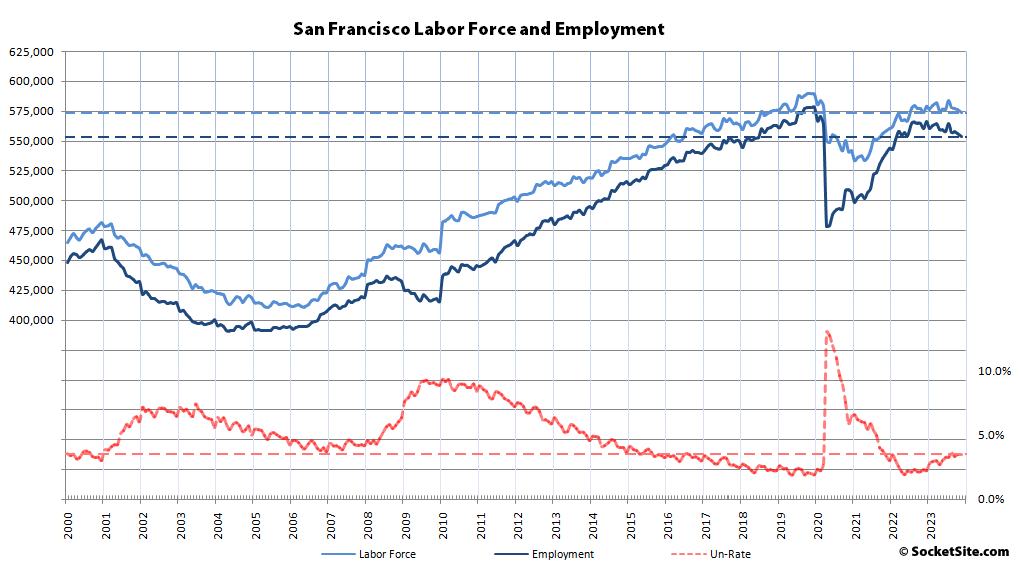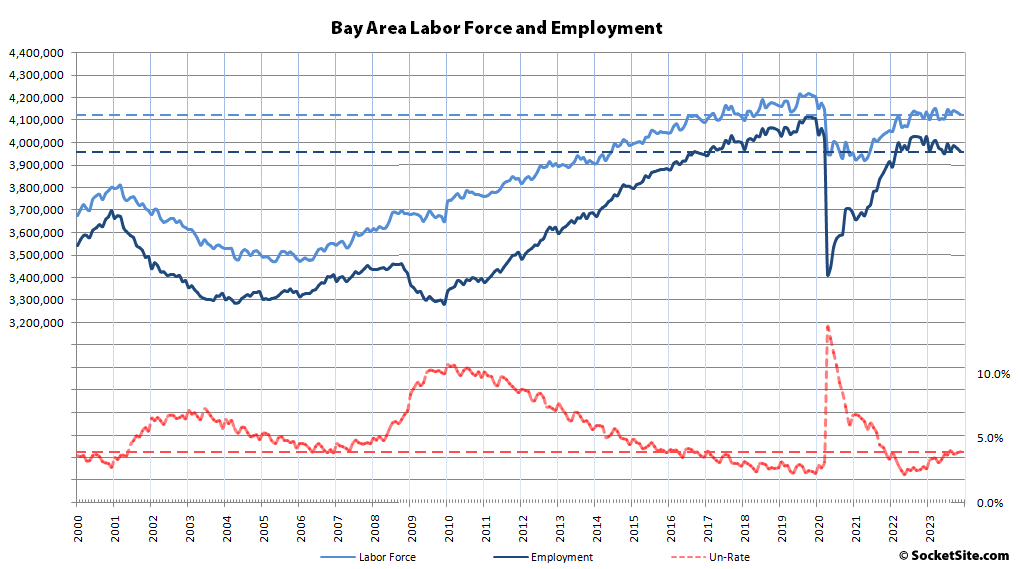Having ticked down by (an upwardly revised) 1,700 in October, the net number of San Francisco residents with a job dropped by 2,200 in November to 553,800. As such, there are 7,000 fewer employed residents in San Francisco than there were at the same time last year, over 24,000 fewer employed residents than there were at the end of 2019, prior to the pandemic, and over 15,000 fewer people in the local labor force (573,00), all despite “an unemployment rate of just 3.5 percent.”
At the same time, the number of employed East Bay residents inched down by 1,900 last month to 1,517,700, representing 8,000 fewer employed residents than there were at the same time last year and nearly 56,000 fewer than there were prior to the pandemic, with around 27,000 fewer people in the East Bay labor force (1,589,400), with an unemployment rate of 4.5 percent.
The number of employed residents spread across San Mateo and Santa Clara Counties inched down by 2,100 in November to 1,453,900, representing 21,000 fewer employed residents than at the same time last year, with nearly 39,000 fewer employed people in Silicon Valley than there were prior to the pandemic and over 14,000 fewer people in the local labor force (1,509,200), with an unemployment rate of 3.7 percent.
Net employment across Marin, Napa and Sonoma counties ticked down by 3,000 in November to 436,200, representing 5,200 more employed residents than there were at the same time last year but 25,000 fewer employed residents than there were prior to the pandemic and 19,000 fewer people in the combined labor force (456,300) for an unemployment rate of 3.7 percent.
And as such, the net number of Bay Area residents with a job (3,961,600) inched down by 9,200 in November and was down by 30,800 on a year-over-year basis, representing the seventh straight month with a year-over-year decline in local employment, with over 140,000 fewer employed residents than there were prior to the pandemic, over 76,000 fewer people in the labor force and local employment effectively back to 2017 levels (and trending down).


Absolutely no compelling reason to grow staff in the Bay Area. Especially so in light of very high cost of living and really poor governance.
Homelessness, poor transport infrastructure, even worse public transport options, bureaucratic barriers & procedural overheads to new development (residential or commercial), over subscribed public services, oversubscribed health services, under powered/under funded public service officials, poor or falling K-12 education standards, high crime, poor accountability and service delivery for high taxes (income/sales and other) – and a region/state heading towards massive deficits.
But for the pump in RE equity because of the Fed put for the last two decades (and inflationary pressure due to unchecked illegal and legal but cheap labor immigration), some benefits by way of Prop 13 – the region has been subject to worsening governance for decades. Enjoy the high value RE while everything devolves to utterly unlivable state.
If someone reading all of that wanted to just concede most of it for the sake of argument, they’d probably follow-up with the observation that the high cost of living — largely due to the high cost of housing — is coming down now, and that high housing costs are the true driver of the majority of social and so-called “governance” ills you named.
And that of course isn’t due to The YIMBY’s “winning” or due to The State forcing municipalities to change zoning to allow for more housing or developers building more affordable housing in exchange for regulatory concessions that the State Legislature has been falling all over themselves making over the past several years so developers will get off their hind quarters and actually build (although all of that has and is happening).
The cost of housing is coming down largely due to rising layoffs and population reduction and the reduced demand that follows from both. Let’s see what happens in the next couple of years when the fall-off in housing construction outpaces the fall off in demand for housing.
Litany of FoxNews talking points aside, the most compelling reason not to grow staff in the Bay Area is the cost of labor, towards which the local cost of living is the main factor, of which housing is by far the largest component. As years of practice have demonstrated, building more and more higher-tier residences puts little or no downward pressure on lower-tier rents and sales prices (and indeed seems only to make all housing more expensive). This is not to gainsay your point that governance continues to deteriorate; such deterioration was inevitable after decades of demonization and privatization of the commons.
i like how issues that resonate with and are major problems for residents can be dismissed as ‘fox talking points’ these days.
they are valid points. they are also emphasized as san francisco-centric problems by right-leaning media outlets to sell ads and distract viewers from realizing that most of these issues exist across america. both can be true.
That said, lets get the trucks rolling and pumps going and throw up a few more houses
These can be dismissed as Fox New talking points because declaring that all of these problems make all of the Bay Area “utterly unlivable” is ridiculous. Yes, some of these problems affect some places in some cities in the Bay Area. But they are hardly representative.
Also, these problems exist everywhere. There is no evidence that they are worse in the Bay Area than anywhere else in this country.
Not to mention that even in SF – the epicenter of TEOTWAWKI – the litany of ills supposedly spawned by “Marxist extremism” (lol) is apparent in only a few neighborhoods in the northeast quarter; the vast majority of residents here never see the tents, bent-over fenta-zombies, and brown-hued sidewalks that portend imminent apocalypse. This is the most dense city in the country, and the most desperate neighborhoods colocate with the city’s hotel districts, so it seems to visitors as if all hell is breaking loose, when the same ills exist in any city in the country where extreme economic inequality prevails – which means these same ills occur in every city in the country (they’re just less visible). But, yeah, the mayor’s a commie.🙄
Exactly. San Francisco has problems. But most of the city is just a beautiful place to live.
It’s actually better after Covid. If you live in the neighborhoods, you probably don’t have to commute downtown every day now for work.
No compelling reason – that would be the case for mature businesses that have been pulling up their sticks over the years. Companies like Oracle, Intel, Tesla, Bechtel, HP come to mind… where you run across armies of impresarios, also-rans and hangers-ons. Which you can hire for less in fly-over country or abroad.
This outflow used to be backfilled by companies that do have compelling reasons to grow in the Bay Area and which don’t really care about the litany of ills you mention, be those valid or just perception. These days however – no more – the funny-money’s drying up, chasing investments elsewhere these days.
You are very, very fortunate indeed if you think the entire Bay Area is “utterly unlivable”. See the world a bit. People live and thrive is much worse conditions.
As for the Bay Area itself, there are some bad areas, but the vast majority of the Bay Area is lovely.
Right, Bay Area governance is “so bad” and of course governance is so much better in…uh…..that place called….yeah….somewhere, it’s good somewhere, probably in a place that I like politically. As usual, the Bay Area economic eulogies will be proven wrong. That is not to say that there’s nothing wrong but there is significant stuff wrong everywhere. You’re just swapping problem sets. Certain talent is here and not leaving. The quality of life for me is very high, and many people I know feel the same way.
‘For me’ is exactly the problem — no area survives economically with only a small sliver of isolated population being content. Clearly you are ‘content’ by continually avoiding large areas of the city, watching dozens of key business close per year, progressing homogenization of what’s left, and living in an area which is a shell of its former glory. Let’s see if 2024 local and state budget cuts finally do impact even those supposedly ‘content’.
Frank C., well, just to be fair to the people arguing that governance is better in other cities, they do have specific places that they say — loudly — are better. You’re correct that they all are places that are unlike S.F. politically. The ones that get named most often are Atlanta, Austin and Miami, FL although not necessarily in that order.
As I am sure you’ve heard by now, a group of mostly billionaires and Nat Friedman, who is the co-founder of California YIMBY that don’t like what local democracy has produced in terms of governance here are trying to start their own new city in Solano County that will be almost double the size of San Francisco so they don’t have to be subject to San Francisco’s political system. So that’ll be the fourth, starting next year.
The Grinch who stole San Francisco
I was watching TGWSC last night, and ended up depressed at how much more functional Whoville seemed:
– Not sure whether it’s NIMBYism or lack of a a Builder’s Remedy, but Whoville seems composed entirely of SFR’s ( didn’t see a single mid-rise); nevertheless, they seemed to have achieved density without architecturally monotonous boxes.
– Despite a near total lack of infrastucture, Mt. Crumpet was impressively utilized as PDR space (well. the first two anyway: no actual Christmas Tree repair occurs, so it’s clear that as in SF the “Repair” element is subject to misuse.)
– As in SF, there is the dog-accompanied, unhoused element, but through collective effort he is turned around from pilferage to useful citizenship. People might say “sure, there’s no fentanyl in Whoville” but as we’re told the Grinch experiences myocarditis, which frequently accompanies drug abuse, I think we can all read between the lines (no pun intended).
And they do all this , apparently, without a single app!
The problem isn’t so much of Tech build up – but one of falling purchasing power. The hedge trade was, or were: RE (in select metros), $BTC/NFT/Crypto and Tech Stocks on margin – over leveraged (with copious manipulation, I would add). And everybody is beginning to get margin called. Deleveraging is here. What we are witness to is manifest moral hazard. If you are in debt – good luck to you!